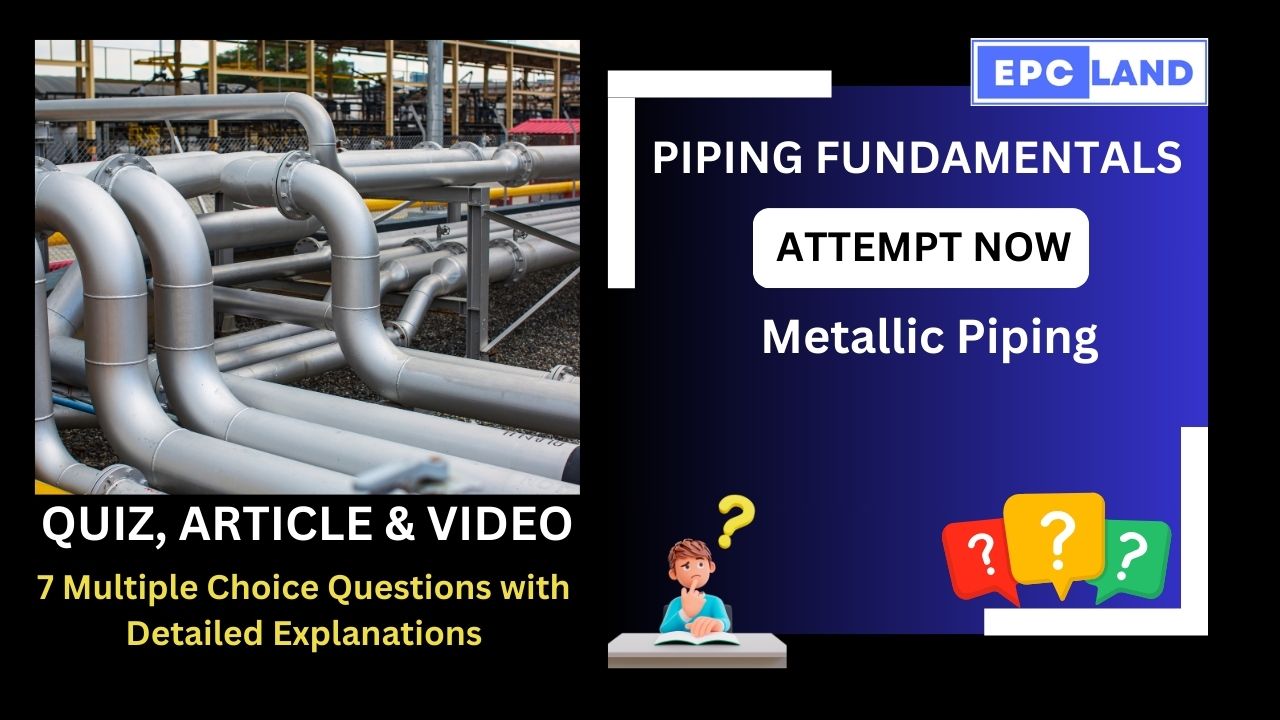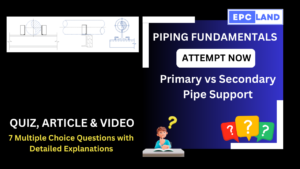1. Carbon Steel Piping
What is the primary advantage of carbon steel pipes, and what challenge do they commonly face?
Explanation: Carbon steel pipes are affordable and versatile but commonly face susceptibility to corrosion, requiring protective coatings or linings.
2. Applications of Nickel Alloy Piping
In which industries are nickel alloys often used for piping, and what properties make them suitable for these applications?
Explanation: Nickel alloys are often used in industries like chemical processing due to their exceptional resistance to corrosion, high temperatures, and harsh chemicals.
3. Advantages of Metallic Piping
What are the key advantages of metallic piping, and why are they considered suitable for demanding applications?
Explanation: Metallic piping offers durability, strength, corrosion resistance, and temperature tolerance, making it suitable for demanding applications.
4. Applications of Duplex and Super Duplex Stainless Steel Piping
Where are duplex and super duplex stainless steel piping commonly used, and what is their unique feature?
Explanation: Duplex and super duplex stainless steel piping are used in industries where resistance to chloride-induced stress corrosion cracking is crucial, such as offshore and marine applications.
5. Applications of Titanium Piping
Where are titanium pipes commonly applied, and what characteristics make them suitable for these applications?
Explanation: Titanium pipes find applications in industries like chemical processing due to being lightweight, strong, and highly resistant to corrosion.
6. Maintenance of Metallic Piping
What are the key considerations for maintaining metallic piping systems?
Explanation: Regular inspection for signs of wear, corrosion, or damage and timely maintenance are key considerations for maintaining metallic piping systems.
7. Conclusion
Why does metallic piping remain a cornerstone of various industries, and what factors contribute to its reliable performance?
Explanation: Metallic piping remains a cornerstone due to its durability, versatility, and ability to withstand demanding conditions with careful material selection, proper installation, and regular maintenance.
Short Article on Metallic Piping
Metallic Piping: A Comprehensive Overview
Metallic piping is a crucial component of various industrial, commercial, and residential systems, transporting fluids, gases, and other materials efficiently and safely. It encompasses a wide range of materials, each offering unique properties and suitability for specific applications.
Types of Metallic Piping
- Carbon Steel Piping: Carbon steel pipes are the most widely used due to their affordability and versatility. They are suitable for a range of applications, including water, oil, and gas transportation. However, they are susceptible to corrosion and may require protective coatings or linings.
- Stainless Steel Piping: Stainless steel pipes offer superior corrosion resistance and come in various grades, each providing different levels of resistance to chemicals and extreme temperatures. They are commonly used in industries like food processing, pharmaceuticals, and petrochemicals.
- Alloy Steel Piping: Alloy steel pipes are designed to handle high temperatures and pressures and are used in industries such as power generation, where pipes need to withstand the conditions of steam and high-pressure gases.
- Copper Piping: Copper pipes are known for their excellent thermal conductivity and corrosion resistance and are often used in plumbing systems for residential and commercial buildings, as well as in HVAC systems.
- Nickel Alloy Piping: Nickel alloys are renowned for their exceptional resistance to corrosion, high temperatures, and harsh chemicals. They are often used in industries such as chemical processing, petrochemicals, oil and gas, aerospace, and many more.
- Titanium Piping: Titanium pipes are lightweight, strong, and highly resistant to corrosion. They find applications in industries like chemical processing, desalination plants, and marine engineering.
- Duplex and Super Duplex Stainless Steel Piping: These specialized stainless steel alloys combine high strength with excellent corrosion resistance. They are used in industries where resistance to chloride-induced stress corrosion cracking is crucial, such as offshore and marine applications.
Advantages of Metallic Piping
- Durability and Strength: Metallic pipes are known for their resilience and ability to withstand high pressures, making them suitable for demanding applications.
- Corrosion Resistance: Various metallic materials offer excellent resistance to corrosion, ensuring long-lasting performance in harsh environments.
- Versatility: Metallic piping systems can be customized to meet diverse requirements in terms of size, shape, and material selection.
- Temperature Tolerance: Metallic pipes can handle a wide range of temperatures, from extreme cold to high heat, depending on the specific material.
Applications of Metallic Piping
Metallic piping plays a vital role in numerous industries, including:
- Oil and Gas: Transportation of crude oil, refined petroleum products, and natural gas.
- Chemical and Petrochemical Processing: Conveying various chemicals, solvents, and reaction fluids.
- Power Generation: Distribution of steam, water, and high-pressure gases in power plants.
- Plumbing and Sanitary Systems: Piping for water supply, drainage, and wastewater disposal.
- HVAC Systems: Distribution of hot and chilled water, steam, and refrigerants for heating, ventilation, and air conditioning.
- Construction and Infrastructure: Piping for water supply, drainage, fire protection, and gas distribution in buildings and infrastructure projects.
Considerations and Maintenance
- Material Selection: Choosing the appropriate material based on the specific application, considering factors like temperature, pressure, corrosion resistance, and compatibility with the transported fluid.
- Proper Installation: Ensuring precise fabrication, welding, and assembly to maintain system integrity and prevent leaks.
- Regular Inspection and Maintenance: Regularly inspecting pipes for signs of wear, corrosion, or damage and conducting timely maintenance to ensure optimal performance and prevent failures.
Conclusion
Metallic piping remains a cornerstone of various industries due to its durability, versatility, and ability to withstand demanding conditions. With careful material selection, proper installation, and regular maintenance, metallic piping systems can provide years of reliable service in diverse applications.
Table of Contents
Don’t miss the Course on Effective Isometrics Management: Check Now
Enrollment Link
Recommended courses (Published on EPCLand)
- Complete Course on Piping Engineering
- Basics of Piping Engineering
- Piping Layout Engineering
- Piping Material Engineering
- Piping Stress Analysis
- Material Requisitions
- Piping Material Specifications
- Valve Material Specifications
- Plant Design & Layouts-OISD 118
- Isometric Management
Library of Technical Articles
Don’t miss out the collection of 15+ articles on following topics:
- Basics of Oil and Gas Industry
- Valves
- Testing
- Tank
- Piping Bulk Items
- Pipe
- Metallurgy
- Piping Materials
- Layout
- Instrumentation
- Heat Exchanger
- Type of Contracts
- Codes and Standards
- ASTM Standards
- Articles on Piping Specialty Items
Video details of Complete Course on Piping Engineering
Why Enroll in the EPCLand
Proven Track Record– PTR
Activities & Achievements before launching EPCLand
- Published more than 50+ short courses
- 3000+ Enrolments
- More than 3,500,00 Minutes of watch hours in the last 2 years
- 4000+ Students in 100+ Countries
- Rating of 4+ out of 5
- 1000+ YouTube Videos
- 8K+ Subscribers
What Students will Learn
- Codes & Standards of the Energy Sector
- Piping Material Engineering
- Piping Layout Engineering
- Stress Analysis
Interesting facts
- All the published courses have been developed by Industry Experts with more than 2 decades of experience
- Content is based on Practical experience and real-time problems.
- Content is designed and organized in such a manner that it can be easily grabbed.
- Complete website, Blogs and Quiz sections are Planned, Designed and published by myself (About me: Atul Singla)
- Complete flexibility of Time & Location, Students can access the content from anywhere & anytime
- Moreover, once enrolled, the content can be access as many times as you want, which helps in understand the fundamentals in a better way.
Conclusion
In conclusion, our courses are meticulously crafted by industry experts with over two decades of hands-on experience. The content is rooted in practical knowledge, addressing real-time problems. The material is thoughtfully designed and organized for easy comprehension. Every aspect, from the website to blogs and quizzes, has been planned, designed, and executed by Atul Singla, ensuring a comprehensive and seamless learning experience. With the flexibility of accessing the content at any time and from any location, students have the freedom to learn on their terms. Furthermore, enrollment grants unlimited access, allowing learners to revisit the material as often as needed, fostering a deep understanding of the fundamentals.



